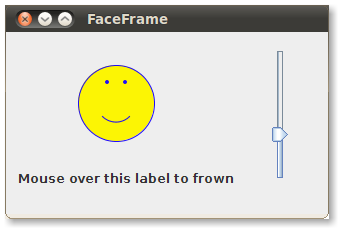Lesson: Writing JavaBeans Components
Writing JavaBeans components is surprisingly easy. You don't need a special tool and you don't have to implement any interfaces. Writing beans is simply a matter of following certain coding conventions. All you have to do is make your class look like a bean — tools that use beans will be able to recognize and use your bean.
However, NetBeans provides some features that make it easier to write beans. In addition, the Java SE API includes some support classes to help implement common tasks.
The code examples in this lesson are based on a simple graphic component called FaceBean, which you can see in the application below.

- FaceBean source code only:
-
FaceBean.java - Entire NetBeans project including FaceBean source code:
-
FaceBean.zip - NetBeans project for an application that uses FaceBean:
-
FaceFrame.zip
A bean is a Java class with method names that follow the JavaBeans guidelines. A bean builder tool uses introspection to examine the bean class. Based on this inspection, the bean builder tool can figure out the bean's properties, methods, and events.
The following sections describe the JavaBeans guidelines for properties, methods, and events. Finally, a section on
BeanInfo shows how you can customize the developer's experience with your bean.
